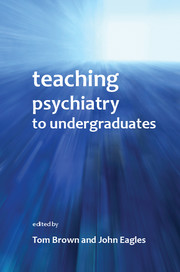Book contents
- Frontmatter
- Contents
- List of figures, tables and boxes
- List of contributors
- Preface
- Foreword
- 1 How do students learn?
- 2 Recent developments in undergraduate medical education
- 3 Undergraduate psychiatry teaching – the core curriculum
- 4 The organisation of undergraduate teaching
- 5 Assessment of undergraduates in psychiatry
- 6 Using computers to teach undergraduate psychiatry
- 7 How to give a lecture
- 8 How to do small-group teaching
- 9 Problem-based learning
- 10 Teaching trainee psychiatrists how to teach medical students: the Southampton model
- 11 Involving trainees in teaching
- 12 Involvement of service users in psychiatric education
- 13 Time-efficient clinical teaching
- 14 Intercalated degrees
- 15 Undergraduate experiences of psychiatry: a student view
- 16 Integration: teaching psychiatry with other specialties
- 17 Teaching the teachers in a cross-cultural setting: the Scotland–Malawi Mental Health Education Project
- 18 International undergraduate teaching
- 19 Teaching with simulated patients and role-play
- 20 Undergraduate medical education and recruitment to psychiatry
- 21 Choosing psychiatry: factors influencing career choice among foundation doctors in Scotland
- 22 Funding of the teaching of medical undergraduates
- 23 Dealing with students in difficulty
- 24 Training medical students to promote good mental health in secondary schools
- 25 Women in medicine
- Index
19 - Teaching with simulated patients and role-play
Published online by Cambridge University Press: 02 January 2018
- Frontmatter
- Contents
- List of figures, tables and boxes
- List of contributors
- Preface
- Foreword
- 1 How do students learn?
- 2 Recent developments in undergraduate medical education
- 3 Undergraduate psychiatry teaching – the core curriculum
- 4 The organisation of undergraduate teaching
- 5 Assessment of undergraduates in psychiatry
- 6 Using computers to teach undergraduate psychiatry
- 7 How to give a lecture
- 8 How to do small-group teaching
- 9 Problem-based learning
- 10 Teaching trainee psychiatrists how to teach medical students: the Southampton model
- 11 Involving trainees in teaching
- 12 Involvement of service users in psychiatric education
- 13 Time-efficient clinical teaching
- 14 Intercalated degrees
- 15 Undergraduate experiences of psychiatry: a student view
- 16 Integration: teaching psychiatry with other specialties
- 17 Teaching the teachers in a cross-cultural setting: the Scotland–Malawi Mental Health Education Project
- 18 International undergraduate teaching
- 19 Teaching with simulated patients and role-play
- 20 Undergraduate medical education and recruitment to psychiatry
- 21 Choosing psychiatry: factors influencing career choice among foundation doctors in Scotland
- 22 Funding of the teaching of medical undergraduates
- 23 Dealing with students in difficulty
- 24 Training medical students to promote good mental health in secondary schools
- 25 Women in medicine
- Index
Summary
Introduction
Simulated patients (SPs) are now very widely used in the teaching and assessment of medical students and of doctors. In psychiatric teaching, SPs have been rather less widely used than in many other medical specialties, partly because of the complexities in the plausible portrayal of psychiatric presentations. Nonetheless, teaching in our specialty with SPs is likely to become more prevalent and thus, notably for younger psychiatrists, it should be helpful to become familiar with the background provided by this chapter, especially in tandem with hands-on experience.
At the outset, some clarification of terms may be helpful. A simulated patient is an umbrella term for anyone who participates in a medical encounter for educational and/or assessment purposes, and this simulation may or may not involve the simulator's own medical history, symptoms or signs. SPs range from relatively untrained community volunteers through to professional actors. A standardised patient is a simulated patient who is specifically trained to produce consistent history, symptoms and signs, as required in student assessments. In role-play, which overlaps with patient simulation, participants are essentially untrained (in fact they are usually the medical students themselves) but their performance is often guided by background details of the role they are asked to play.
The chapter covers the following: historical background; whether, in psychiatric teaching, SPs should be actors; the practical aspects of teaching with SPs and what can be taught using them; the authors’ experience in Aberdeen; assessment and research using SPs; role-play; and the advantages and disadvantages of SPs.
Historical background
There are three good reviews of early developments in the use of SPs for teaching and assessment, by Barrows (1993), Wallace (1997) and Ainsworth et al (1991). Howard Barrows is recognised as the ‘father’ of this innovation, and he first used the technique in 1963 (Wallace, 1997). In his first post as a neurologist in Los Angeles, he coached a young woman to present with abnormal neurological findings and then to report on the performances of his students. Colleagues greeted his ideas with general scepticism (Barrows, 1993) and in non-medical circles his practices were vaguely ridiculed, for example attracting press coverage with the headline ‘Hollywood Invades USC Medical School’ (Wallace, 1997).
- Type
- Chapter
- Information
- Teaching Psychiatry to Undergraduates , pp. 230 - 244Publisher: Royal College of PsychiatristsPrint publication year: 2011

